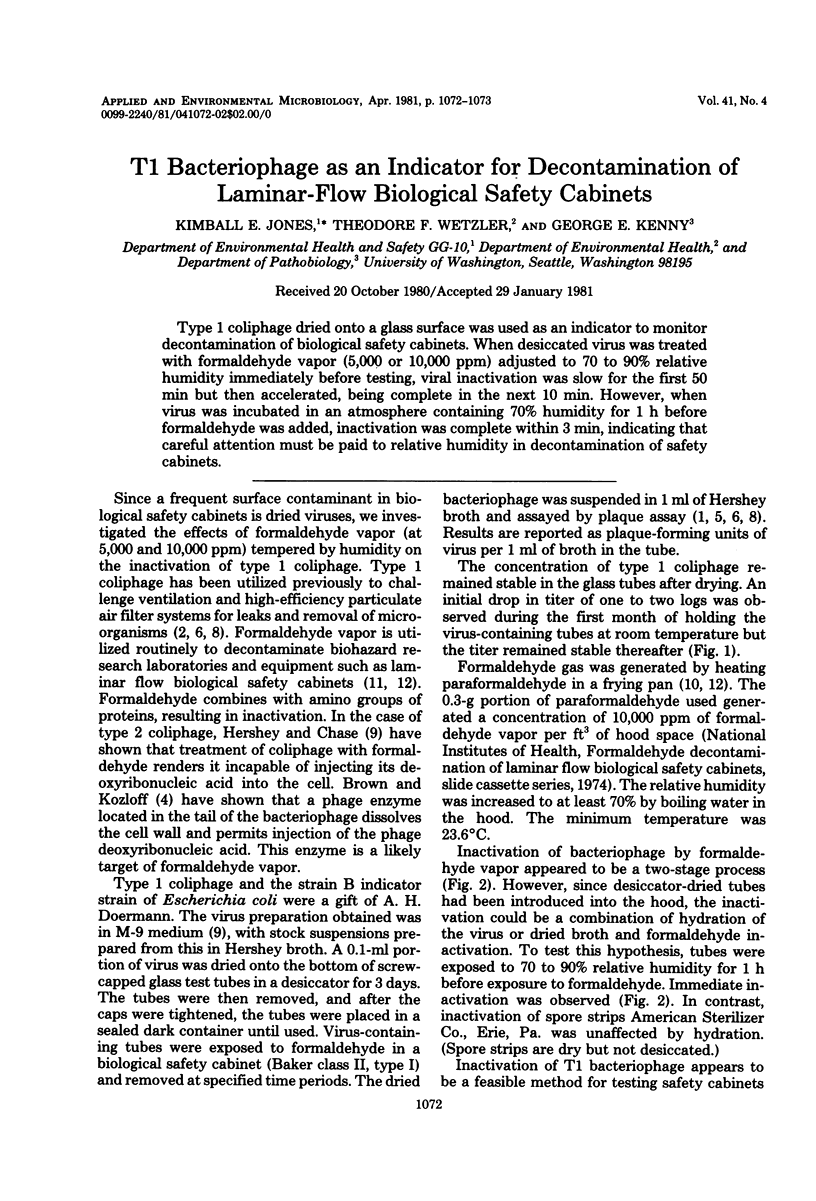Abstract
Type 1 coliphage dried onto a glass surface was used as an indicator to monitor decontamination of biological safety cabinets. When desiccated virus was treated with formaldehyde vapor (5,000 or 10,000 ppm) adjusted to 70 to 90% relative humidity immediately before testing, viral inactivation was slow for the first 50 min but then accelerated, being complete in the next 10 min. However, when virus was incubated in an atmosphere containing 70% humidity for 1 h before formaldehyde was added, inactivation was complete within 3 min, indicating that careful attention must be paid to relative humidity in decontamination of safety cabinets.
Full text
PDF

Selected References
These references are in PubMed. This may not be the complete list of references from this article.
- BROWN D. D., KOZLOFF L. M. Morphological localization of the bacteriophage tail enzyme. J Biol Chem. 1957 Mar;225(1):1–11. [PubMed] [Google Scholar]
- Barbeito M. S., Brookey E. A., Jr Microbiological hazard from the exhaust of a high-vacuum sterilizer. Appl Environ Microbiol. 1976 Nov;32(5):671–678. doi: 10.1128/aem.32.5.671-678.1976. [DOI] [PMC free article] [PubMed] [Google Scholar]
- Batty E., Farmer Y. L., Breame A. J., Bruce W. The effect of relative humidity on swine vesicular disease virus in dried films before and during formaldehyde fumigation. J Hyg (Lond) 1979 Apr;82(2):255–261. doi: 10.1017/s0022172400025675. [DOI] [PMC free article] [PubMed] [Google Scholar]
- Chase M, Doermann A H. High Negative Interference over Short Segments of the Genetic Structure of Bacteriophage T4. Genetics. 1958 May;43(3):332–353. doi: 10.1093/genetics/43.3.332. [DOI] [PMC free article] [PubMed] [Google Scholar]
- Doermann A. H., Eiserling F. A., Boehner L. Genetic control of capsid length in bacteriophage T4. I. Isolation and preliminary description of four new mutants. J Virol. 1973 Aug;12(2):374–385. doi: 10.1128/jvi.12.2.374-385.1973. [DOI] [PMC free article] [PubMed] [Google Scholar]
- HERSHEY A. D., CHASE M. Independent functions of viral protein and nucleic acid in growth of bacteriophage. J Gen Physiol. 1952 May;36(1):39–56. doi: 10.1085/jgp.36.1.39. [DOI] [PMC free article] [PubMed] [Google Scholar]
- Harstad J. B., Decker H. M., Buchanan L. M., Filler M. E. Air filtration of submicron virus aerosols. Am J Public Health Nations Health. 1967 Dec;57(12):2186–2193. doi: 10.2105/ajph.57.12.2186. [DOI] [PMC free article] [PubMed] [Google Scholar]
- Harstad J. B. Sampling submicron T1 bacteriophage aerosols. Appl Microbiol. 1965 Nov;13(6):899–908. doi: 10.1128/am.13.6.899-908.1965. [DOI] [PMC free article] [PubMed] [Google Scholar]
- Jensen M. M. Bacteriophage aerosol challenge of installed air contamination control systems. Appl Microbiol. 1967 Nov;15(6):1447–1449. doi: 10.1128/am.15.6.1447-1449.1967. [DOI] [PMC free article] [PubMed] [Google Scholar]
- Songer J. R., Braymen D. T., Mathis R. G., Monroe J. W. The practical use of formaldehyde vapor for disinfection. Health Lab Sci. 1972 Jan;9(1):46–55. [PubMed] [Google Scholar]
- Spicher G., Peters J. Resistenz mikrobieller Keime gegenüber Formaldehyd. I. Vergleichende quantitative Untersuchungen an einigen ausgewählten Arten vegetativer Bakterien, bakterieller Sporen, Pilze, Bakteriophagen und Viren. Zentralbl Bakteriol Orig B. 1976 Dec;163(5-6):486–508. [PubMed] [Google Scholar]
- Taylor L. A., Barbeito M. S., Gremillion G. G. Paraformaldehyde for surface sterilization and detoxification. Appl Microbiol. 1969 Apr;17(4):614–618. doi: 10.1128/am.17.4.614-618.1969. [DOI] [PMC free article] [PubMed] [Google Scholar]


